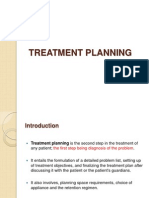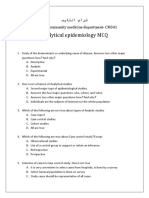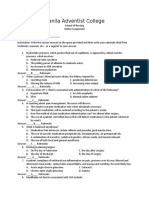FCD Ethical and Legal Issues
FCD Ethical and Legal Issues
Uploaded by
nicholas51292Copyright:
Available Formats
FCD Ethical and Legal Issues
FCD Ethical and Legal Issues
Uploaded by
nicholas51292Original Title
Copyright
Available Formats
Share this document
Did you find this document useful?
Is this content inappropriate?
Copyright:
Available Formats
FCD Ethical and Legal Issues
FCD Ethical and Legal Issues
Uploaded by
nicholas51292Copyright:
Available Formats
IDNT3361/3362 FCD III Ethical and Legal Issues Assignment Scenario III
Group Members
Yousr Kanbour Yusef Khadembashi Ilana Kohan Xinyi Lai Ealin Lee Penelope Lindsay Rueda Nicholas Liyanage (20777258) Vernice Lo Chee Kian Loy
In a time where litigation rules our dental practices, it is important to obtain informed consent from a well advised patient. Similarly, it is important for a dentist to only perform treatment that is consistent with their own ability and that they feel is adequate for the patients treatment needs and expectations. With a wide access to information, patients have increasingly become aware of treatment types and have expectations of treatment outcomes. In some cases these expectations are unrealistic and as a dentist it is important to ensure that we provide our patients with the relevant information required to make a balanced clinical judgement about the types, cost, timeframe, implications and consequences of treatment, this protects not only the dentist, but also benefits the patients in the long run. In this scenario, the 22 year old patient has demanded crown treatment, which WHAT FACTORS ARE INVOLVED Treatment options for the aesthetic restoration of anterior teeth can range from minimally invasive procedures to procedures which involve the extensive removal of tooth structure. To decide which treatment that will produce the most optimum outcome for this patient, it is important to consider her age, the state of her existing dentition, the cause of the staining, her caries risk level, her financial limitations, patient education and the dentists skill and willingness to perform the procedure. Age is an important factor to consider - having extensive restorations placed at a young age would mean a lifetime of replacing these restorations, with each replacement removing more tooth structure. It is crucial to examine the state of the existing dentition before deciding what treatment to undertake. Doing extensive restorations on perfectly intact teeth is over treating and unnecessary and alternative options should be considered. The cause of the staining should be investigated - often staining is caused by smoking or diet, and these extrinsic stains can be removed and prevented in the future. The patients caries risk is highly influential in deciding treatment - assessment of their diet and oral hygiene is a necessity. A patient with little motivation to maintain oral hygiene will have their caries and periodontal disease risk elevated by the placement of crowns. Although the patient has stated that cost is not an issue, it is not clear whether the patient has been made known that she may require endodontic or periodontic treatment before her restorative treatment commences. Furthermore there is likely to be expensive ongoing cost such a replacement of the crowns after a number of years, or future endodontic and periodontal problems. The patient needs to be made fully understood that crowns are not a conservative option, there is no way of restoring the tooth structure that will be need to be removed for the crowns and that by having this treatment they will be predisposing themselves to other dental conditions for life. The patient needs to also be educated about other more conservative options before commencement of treatment. It is highly unlikely that the patient is aware that they can achieve a very similar aesthetic result with a much more conservative option such a composite restoration or a veneer, even bleaching. REFERENCES : case selection and overtreatment
OPTIONS YOU WOULD CONSIDER The patient needs to be educated on what other treatment options are available to her, and should be encouraged to pursue a less invasive treatment option. Bleaching could be a treatment that has the potential to lead to a satisfactory aesthetic result. As the teeth are currently minimally restored, bleaching is appropriate as the contour and occlusion of the teeth will not be altered, and minimal risks exist as a result of treatment. If the outcome of bleaching is not desirable, more invasive options could be considered. Porcelain veneers, whilst more invasive than bleaching, can result in greatly enhanced aesthetics. These could be considered as a treatment option if bleaching is unsuccessful, or if contraindications exist to bleaching. The use of composite to build up the teeth is possible, but has limited aesthetic value if the staining is extensive, and therefore the patients presenting complaint has not been fully addressed. Composite would have to be very thick to give an aesthetic outcome, and this would result in changes in the contour and occlusion of the teeth that would most likely be unacceptable. Crowning of all the maxillary teeth is the option that the patient desires, and this needs to be considered as a potential treatment. However, as the indications for treatment are purely aesthetic and the patient is young, crowning of the teeth should really be discouraged. Crowns need regular maintenance, and are unlikely to last for the lifetime of the patient, necessitating the need for more tooth preparation and loss of tooth structure. However, crowns, whether full ceramic crowns or PFM crowns, can lead to a highly aesthetic outcome for the patient. If the patient (after being educated on her options) still is insistent on crowns, a compromise could be made to only crown the teeth that are visible on smiling. No treatment is also an option that needs to be presented, because the patient is in no pain and has no dental disease. The patient needs to be aware that the treatment she is requesting is purely aesthetic, but it will have lifelong biological effects.
LEGAL AND MORAL/ETHICAL PRINCIPLES In this case the dentists actions are governed by a series of moral and ethical principles outlined by both of the major Australian Dental Associations. A dental practitioner has a greater level of knowledge in the field when compared to the patient and thus has an ethical and legal responsibility to assist the patient in making a well-informed decision about any potential treatment. The dentist must always provide information regarding the risks, cost and consequences of the treatment they wish to undertake. This is particularly so in cases of cosmetic importance. In the case of the decision to treat generalised staining with multiple full coverage PFM crowns, the patient should be informed about the estimated cost, number of appointments required and problems associated with multiple crowned teeth such as a requirement for more stringent oral hygiene habits. The patient should also be advised of other possible treatment options and what makes them more or less favourable. Effort should be made to provide as much information as is appropriate and relevant. The dentist should always strive to ensure conservation of natural tooth structure to ensure the best possible prognosis for the remainder of the tooth structure. This is a very
important principle in this case. However it is most critical that the patients freedom of choice is respected and that if they have been given the proper facts they can make their own informed decision to receive the treatment they desire. In this scenario if the patient is determined to have all teeth crowned, the dentist must express any concerns regarding this treatment option including the unsuitability of the treatment, and if applicable, inform the patient of your level of experience and expertise as an undergraduate dentist. Medico-legal issues must be considered prior to the commencement of any dental treatment. To best avoid litigation, when the treatment plan has been confirmed the dentist must obtain written consent from the patient. It is also advisable to ensure meticulous record-keeping as proof of all discussions held with the patient.
ADVICE
Her case does not indicate for a crown and bridge treatment in terms of invasiveness of treatment Compare indications of treatment available for tooth discoloration. These include bleaching, porcelain laminate veneers. For bleaching, it is indicated for minimally invasive treatment, whilst for laminate veneers it is indicated when greater aesthetic control is desired. Compare advantages, disadvantages, implications and consequence of the different options available. o In terms of invasiveness, bleaching is the least, followed by laminate veneers and then by crowns. Moreover, with any tooth structure removal, these procedures are irreversible and destructive. And the more destructive the procedure the more care and thought should be given long term prognosis of the treatment. o In particularly, although every treatment will require maintenance, crown needs a greater degree of maintenance. Given her young age, such destructive option undertaken would eventually have implication on long term oral health maintenance. Therefore, made known other options are available, which are less invasive in nature. o Bleaching is not without its risk, compared to laminate veneers, it has limited aesthetic improvement and it has gingival recession risk. o For porcelain laminate veneers, they require resin bonding, despite being cheaper than crowns it still has desirable aesthetic improvement and clinically proven longevity. After providing relevant information, allow patient to make a decision based on free will, eventually the treatment option picked up is dependent on patient choice/demand, which at the same time means the patient has to be responsible for her teeth and the treatment she chooses. Upon which if you as a dentist do not feel comfortable, the patient can be referred. Whilst informing patient of your reason of doing so. Dietary advice - parafunctional habits too. If they want teeth they are happy with, they have to do the right things to look after them
ACTIONS It is of the utmost importance that the patient is thoroughly informed about all of their treatment options and the route of action that the clinician intends to take. In this scenario, the destructive disadvantages involved with such largely invasive treatment significantly outweigh any benefits perceived by the patient. It is the responsibility of the clinician to explain why placing crowns on many healthy teeth is not an appropriate treatment. They must also ensure that they supply the patient with informative literature about the alternative treatment options available to them as well as answering any additional questions the patient may have. The motivations behind the requested treatment are also an aspect that should be considered in the discussion of the available treatment options. Understanding the purpose behind the desired treatment may allow the clinician to assist the patient in making an informed decision. Regardless of which treatment the patient and clinician decide to undertake, treatment of the cause of the staining is of primary importance and must be undertaken. If, even after extensive discussion about the unsuitability of the proposed treatment, the patient decides that she still wants crowns on all her teeth and the clinician does not feel that they have the required skills necessary to carry out the treatment, the patient should be referred to another clinician. If the clinician agrees to go ahead with the proposed treatment, they must ensure that the patient provides the necessary informed consent paperwork as well as keeping detailed records which will be needed in the event of future litigation or grievances.
References
You might also like
- CDS Andreas KalckerDocument36 pagesCDS Andreas KalckerevimaggNo ratings yet
- Detailed Case History in C - DDocument54 pagesDetailed Case History in C - Dvahini niharika100% (8)
- Dental Negligence in Clinical PracticeDocument18 pagesDental Negligence in Clinical PracticeLutfun NessaNo ratings yet
- Guide To Gastrointestinal Oncology The Clinician Guide To GI SeriesDocument436 pagesGuide To Gastrointestinal Oncology The Clinician Guide To GI SeriesCirnu Alina50% (2)
- 2019 Monitoreo Hemodinamico PDFDocument476 pages2019 Monitoreo Hemodinamico PDFCurro Miralles100% (1)
- SADJ May 2014 - Ethical Issues in Replacing A Single Tooth With A Dental ImplantDocument2 pagesSADJ May 2014 - Ethical Issues in Replacing A Single Tooth With A Dental ImplantdrjonduNo ratings yet
- Solving Ethical Dilemmas in Dental Hygiene Practice: by Marcy Ortiz, RDH, BADocument11 pagesSolving Ethical Dilemmas in Dental Hygiene Practice: by Marcy Ortiz, RDH, BAHAMIDNo ratings yet
- D L, H R & L L: Periodontology 2000Document24 pagesD L, H R & L L: Periodontology 2000ph4nt0mgr100% (1)
- DR Srivatsa G - History TakingDocument43 pagesDR Srivatsa G - History TakingSupriya ShuklaNo ratings yet
- Ortho Consent Form (ALIGNERS)Document2 pagesOrtho Consent Form (ALIGNERS)navincoolkarniNo ratings yet
- AsplDocument9 pagesAsplCristinaNo ratings yet
- DocumentDocument14 pagesDocument6202411002No ratings yet
- Treatment Planning in Operative Dentistry: Dr. Ignatius LeeDocument42 pagesTreatment Planning in Operative Dentistry: Dr. Ignatius LeeDrMohmed MostafaNo ratings yet
- Treatment Planning in Operative Dentistry: Dr. Ignatius LeeDocument42 pagesTreatment Planning in Operative Dentistry: Dr. Ignatius LeeDaniel Wang100% (1)
- Ethics 2Document3 pagesEthics 2sandeep lachhwaniNo ratings yet
- Simplified CDDocument16 pagesSimplified CDSthithika ShettyNo ratings yet
- Case Presentation: " Class - Modification - "Document2 pagesCase Presentation: " Class - Modification - "raghh roooNo ratings yet
- Chao Pinhole Surgical Technique Consent FormDocument2 pagesChao Pinhole Surgical Technique Consent FormDavidNo ratings yet
- Papel SymourDocument24 pagesPapel Symourjuanandresro93No ratings yet
- Waterpik Treatment Planning For Implant Dentistry ContinuingEducationDocument12 pagesWaterpik Treatment Planning For Implant Dentistry ContinuingEducationGreen Sleeves100% (1)
- CD CareDocument8 pagesCD CareAkshayNo ratings yet
- Implant 0Document1 pageImplant 0Dentist HereNo ratings yet
- 3 Treatment PlanningDocument23 pages3 Treatment PlanningMihaela BorovinăNo ratings yet
- Diagnosis & Treatment Planning For Edentulous PatientDocument9 pagesDiagnosis & Treatment Planning For Edentulous PatientChhavi sharmaNo ratings yet
- Hakam Rabi: Department of Radiology & DiagnosisDocument15 pagesHakam Rabi: Department of Radiology & Diagnosisاسراء اكرم هيمونيNo ratings yet
- Ecde 18 01005 PDFDocument14 pagesEcde 18 01005 PDFJawad TariqNo ratings yet
- Chapter 35Document4 pagesChapter 35WAHDALENA WAHIDINNo ratings yet
- Kkamm Perio Research PaperDocument8 pagesKkamm Perio Research Paperapi-455560394No ratings yet
- Diagnosis and Treatment Planning of CD PatientsDocument95 pagesDiagnosis and Treatment Planning of CD PatientsAnjana ThomasNo ratings yet
- Dental Implant ConsentDocument3 pagesDental Implant ConsentSonia shitoleNo ratings yet
- Introducing Dental ImplantsDocument13 pagesIntroducing Dental ImplantsKeyser SozeNo ratings yet
- Management of Oral Cancer (1) ...Document3 pagesManagement of Oral Cancer (1) ...Mircea IlieNo ratings yet
- Diagnosis and Treatment Plan of CDDocument12 pagesDiagnosis and Treatment Plan of CDIbrahim HashimiNo ratings yet
- Perio Paper-FinalDocument8 pagesPerio Paper-Finalapi-547158281No ratings yet
- Consentfor Composite VeneersDocument2 pagesConsentfor Composite VeneersEking InNo ratings yet
- J. Foster 2008Document4 pagesJ. Foster 2008ggs8320No ratings yet
- ORTHO - Treatment Planning and Management of Class I MalocclusionDocument31 pagesORTHO - Treatment Planning and Management of Class I MalocclusionLailathul Bathur Kalikul Jaman50% (2)
- Reflection PreventionDocument2 pagesReflection Preventionapi-608273689No ratings yet
- Log of Literature DhiiDocument7 pagesLog of Literature Dhiiapi-733563770No ratings yet
- Section One - Fundamentals of Implant Dentistry: Chapter 1 - How To Recognize A Mainstream CaseDocument6 pagesSection One - Fundamentals of Implant Dentistry: Chapter 1 - How To Recognize A Mainstream CaseKomal TalrejaNo ratings yet
- Total Health Seminar E-MailerDocument1 pageTotal Health Seminar E-MailerHenryScheinDentalNo ratings yet
- 0022 3913 (65) 90060 0Document14 pages0022 3913 (65) 90060 0barrera2001No ratings yet
- Screenshot 2024-06-17 at 9.02.41 PMDocument12 pagesScreenshot 2024-06-17 at 9.02.41 PMايمن صباح عبد حماديNo ratings yet
- The Removable Partial Denture EquationDocument10 pagesThe Removable Partial Denture Equationapi-3710948100% (1)
- Dental Town20 HOGOpg20Document3 pagesDental Town20 HOGOpg20Tahir AliNo ratings yet
- Dental AidDocument6 pagesDental AidCroitort530% (1)
- Tooth ExtractionDocument9 pagesTooth ExtractionChandraPrakaash100% (2)
- 1 s2.0 S001185322200595X MainDocument15 pages1 s2.0 S001185322200595X MainRashmita NayakNo ratings yet
- 1.introduction To Restorative DentistryDocument1 page1.introduction To Restorative DentistryramenatttNo ratings yet
- Need and Demand For TreatmentDocument5 pagesNeed and Demand For TreatmentMohsin HabibNo ratings yet
- History and Clinical Examination (1st Lecture)Document16 pagesHistory and Clinical Examination (1st Lecture)Ali IbraheemNo ratings yet
- Orthodontic Management in Children With Special NeedsDocument5 pagesOrthodontic Management in Children With Special NeedsAnonymous LnWIBo1GNo ratings yet
- Lec 1 Dental Problems of Children With Special Health Care NeedsDocument11 pagesLec 1 Dental Problems of Children With Special Health Care Needsفاطمة احمد غضبان الزياديNo ratings yet
- Implant-Consent (1)Document4 pagesImplant-Consent (1)yaikobderejeNo ratings yet
- Problem in Complete Denture Treatment and Postinsertion DentureDocument35 pagesProblem in Complete Denture Treatment and Postinsertion DentureSorabh JainNo ratings yet
- GDC Scope of PracticeDocument4 pagesGDC Scope of Practicesam paulNo ratings yet
- Informed Consent For The Orthodontic Patient: Consent of Orthodontic Treatment Provided by DR Mohammed AlmuzianDocument8 pagesInformed Consent For The Orthodontic Patient: Consent of Orthodontic Treatment Provided by DR Mohammed AlmuzianVidal Almanza AvilaNo ratings yet
- Lec01.clinical ExaminationDocument4 pagesLec01.clinical ExaminationLateef K Al-RubaeiNo ratings yet
- Log of Literature DhiiDocument10 pagesLog of Literature Dhiiapi-733637938No ratings yet
- Clinical Examination Lec 1Document4 pagesClinical Examination Lec 1Fatimah AmjedNo ratings yet
- Periodontal Research PaperDocument8 pagesPeriodontal Research Paperapi-279944111No ratings yet
- Art 2 Protesis RemovibleDocument14 pagesArt 2 Protesis RemovibleLaurita Ayala ChiquilloNo ratings yet
- HC113 04 UK MICMIC KEY EnteralFeeding ProductCatalogue 2020 1Document20 pagesHC113 04 UK MICMIC KEY EnteralFeeding ProductCatalogue 2020 1Salah AnamNo ratings yet
- Chapter 38. Medication Reconciliation: BackgroundDocument14 pagesChapter 38. Medication Reconciliation: BackgroundnurhaidahNo ratings yet
- Test GADDocument4 pagesTest GADRada LiviaNo ratings yet
- Council 2019 AnswerDocument56 pagesCouncil 2019 AnsweralicNo ratings yet
- Humoral Immune ResponseDocument22 pagesHumoral Immune ResponseAlunaficha Melody KiraniaNo ratings yet
- Case NCP MelbaDocument2 pagesCase NCP MelbabambheesyeoboNo ratings yet
- Discovery of PenicillinDocument5 pagesDiscovery of PenicillinazlanNo ratings yet
- Kasus KulitDocument1 pageKasus KulitVirda Desta100% (1)
- Drug Study Magnesium SulfateDocument3 pagesDrug Study Magnesium SulfateSchyna Marielle VitaleNo ratings yet
- Case Study 1 (Muscular) - ALSDocument5 pagesCase Study 1 (Muscular) - ALSSamantha AquinoNo ratings yet
- Analytical epidemiology MCQs فراسDocument12 pagesAnalytical epidemiology MCQs فراسHisokagen100% (2)
- SBI 2019: Masterlisting Form For Kinder To Grade 7 LearnersDocument1 pageSBI 2019: Masterlisting Form For Kinder To Grade 7 LearnersJhun Bel PadrillanNo ratings yet
- University of Edinburgh List of Priority Chinese Universities 0Document7 pagesUniversity of Edinburgh List of Priority Chinese Universities 0HUANG YUXIAO (Seroja)No ratings yet
- Ectopic Pregnancy Treatment & ManagementDocument12 pagesEctopic Pregnancy Treatment & ManagementDebi SumarliNo ratings yet
- Health Experts Meet Telangana Governor DR Tamilisai Soundararajan: Memorandum Submitted To Telangana GovernorDocument2 pagesHealth Experts Meet Telangana Governor DR Tamilisai Soundararajan: Memorandum Submitted To Telangana GovernorbobbyramakantNo ratings yet
- CCT in Anaesthetics - Assessment Blueprint Aug 2010 V1.3Document14 pagesCCT in Anaesthetics - Assessment Blueprint Aug 2010 V1.3sherif11110% (1)
- Tugas Bahasa IngDocument8 pagesTugas Bahasa IngHidayatul Umi RohmahNo ratings yet
- BHW TRAINING Neonate and Infant HealthDocument24 pagesBHW TRAINING Neonate and Infant HealthWilma BeraldeNo ratings yet
- Case of Thoracic Outlet Syndrome - Cervical Rib: Presented and Discussed By: DR Praveen C.RDocument42 pagesCase of Thoracic Outlet Syndrome - Cervical Rib: Presented and Discussed By: DR Praveen C.RPraveen CrNo ratings yet
- Online Assignment 5Document4 pagesOnline Assignment 5dia diaNo ratings yet
- AV Fistula - What The Patient Needs To Know. in MarathiDocument2 pagesAV Fistula - What The Patient Needs To Know. in MarathidrnikhilpanseNo ratings yet
- Acs UpdateDocument64 pagesAcs Updatekamel6No ratings yet
- Role of Ayurveda in Treating Cervical ErosionDocument9 pagesRole of Ayurveda in Treating Cervical Erosionrazvan rotaruNo ratings yet
- CMMC Case - A Diagnostic DilemmaDocument10 pagesCMMC Case - A Diagnostic DilemmaADINo ratings yet
- Adenoid Hypertrophy in Adults: JSM Head and Face MedicineDocument3 pagesAdenoid Hypertrophy in Adults: JSM Head and Face Medicineidunk cristiNo ratings yet
- CV Serviceline WhitepaperDocument12 pagesCV Serviceline WhitepaperAbidi HichemNo ratings yet
- Wound Dressing For Caesarean Section ObstetricsDocument9 pagesWound Dressing For Caesarean Section ObstetricsAddisNo ratings yet

























































































